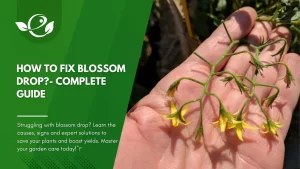Table of Contents
Imagine transforming a dull corner of your living room into a verdant oasis—with minimal fuss and maximum impact. Enter the Bamboo Palm (Chamaedorea seifrizii), a clumping houseplant prized for its graceful, bamboo‑like canes and feathery, air‑purifying fronds. Whether you’re a busy professional craving a low‑maintenance green companion or a plant enthusiast seeking a touch of the tropics, the Bamboo Palm delivers year‑round beauty with surprisingly simple care requirements.
In this expert guide, you’ll discover how to recreate the palm’s native rainforest conditions indoors—from providing the perfect balance of bright, indirect light to maintaining humidity levels that prevent those dreaded brown leaf tips. We’ll walk through soil and potting best practices, watering techniques that keep roots healthy without risking rot, and seasonal fertilization schedules that fuel steady growth. You’ll also learn to spot early signs of pests and diseases—and tackle them before they threaten your palm’s vitality.
By the end of this article, you’ll be equipped with the insider knowledge to help your Bamboo Palm thrive, adding a lasting touch of tropical elegance—and cleaner air—to your home.
Understanding Bamboo Palm
What Is a Bamboo Palm?
The Bamboo Palm, scientifically known as Chamaedorea seifrizii, is a clumping palm featuring upright canes that resemble bamboo and delicate, pinnate fronds that arch gracefully. Its compact growth habit (4–12 ft tall indoors) and tolerance for lower light levels make it one of the most popular houseplants in the Chamaedorea genus.
Why Grow a Bamboo Palm Indoors?
Bamboo Palms are not only attractive—they’re also non‑toxic and pet‑friendly, making them safe for homes with children and animals. They improve indoor air quality by filtering pollutants while adding a tropical aesthetic that complements virtually any décor.
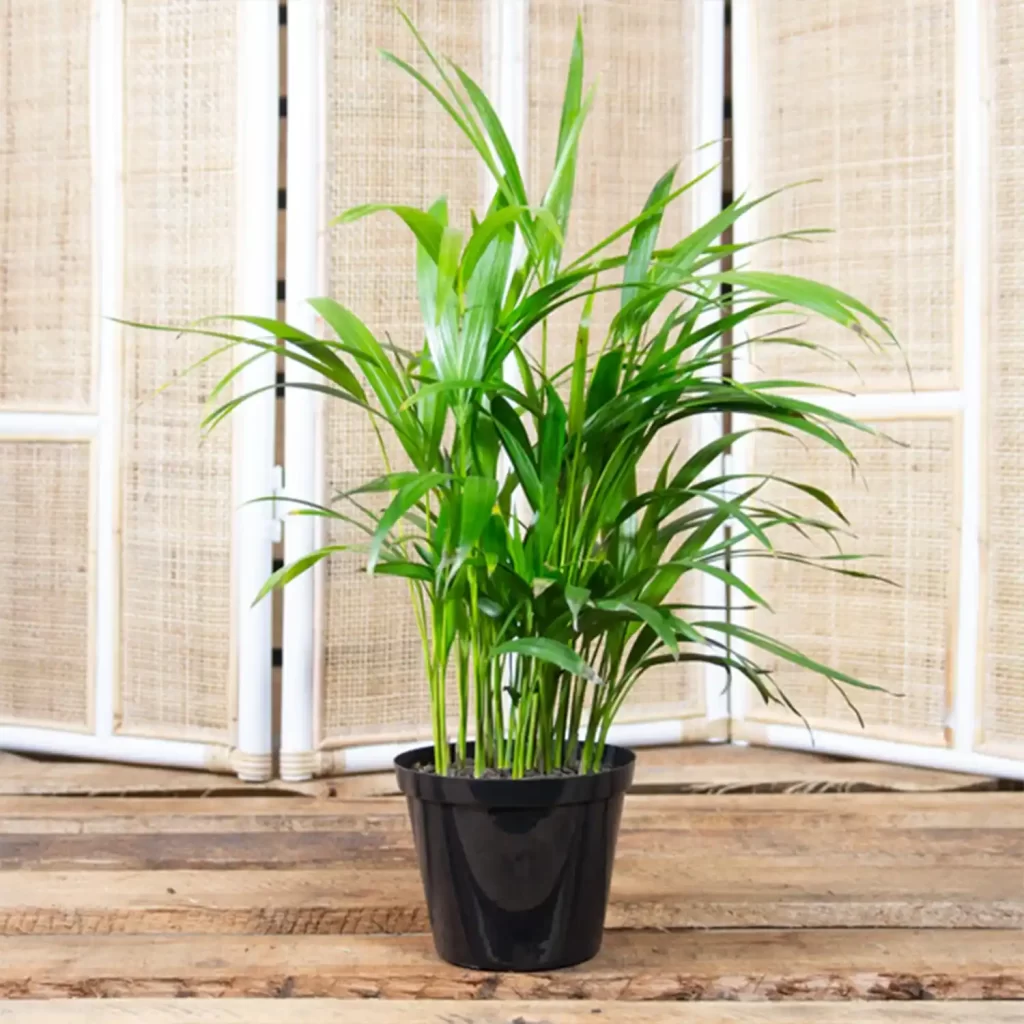
Key Details
| Attribute | Details |
|---|---|
| Common Name | Bamboo Palm |
| Other Common Names | Parlor Palm, Reed Palm, Clustered Parlor Palm, Cane Palm |
| Botanical Name | Chamaedorea seifrizii |
| Family | Arecaceae |
| Plant Type | Evergreen perennial, indoor houseplant |
| Mature Size | 3–8 ft (0.9–2.4 m) tall; 1–10 ft (0.3–3 m) wide |
| Light Requirements | Bright, indirect to low light; avoid direct sun |
| Soil Type | Moist but well‑drained potting mix (peat‑based with perlite/pumice) |
| Soil pH | Slightly acidic (6.1–7.5) |
| Hardiness Zones | USDA 10–11 (roots hardy to zone 9 but fronds frost‑sensitive) |
| Native Area | Understory of rainforests in Mexico and Central America |
| Toxicity | Non‑toxic to humans, cats, and dogs |
Benefits of Growing Bamboo Palm
- Air Purification: Removes harmful VOCs such as benzene, formaldehyde, and trichloroethylene, improving indoor air quality.
- High Oxygen Output: Its slender, feathery fronds deliver impressive photosynthesis, boosting oxygen levels in living spaces.
- Humidity Booster: Transpiration from the fronds adds moisture to the air, which can help alleviate dry skin and respiratory discomfort.
- Low Maintenance: Thrives in low to medium light and requires watering only when the top inch of soil dries out, making it ideal for beginners.
- Pet and Child Safe: Non‑toxic to cats, dogs, and humans, so you can enjoy greenery without worry.
- Stress Reduction & Mental Well‑Being: Studies show interaction with houseplants lowers cortisol and promotes relaxation—Bamboo Palm’s calming presence enhances focus and mood.
- Aesthetic & Décor Versatility: Its elegant bamboo‑like canes and lush fronds suit modern and traditional interiors alike, adding a structural, tropical accent.
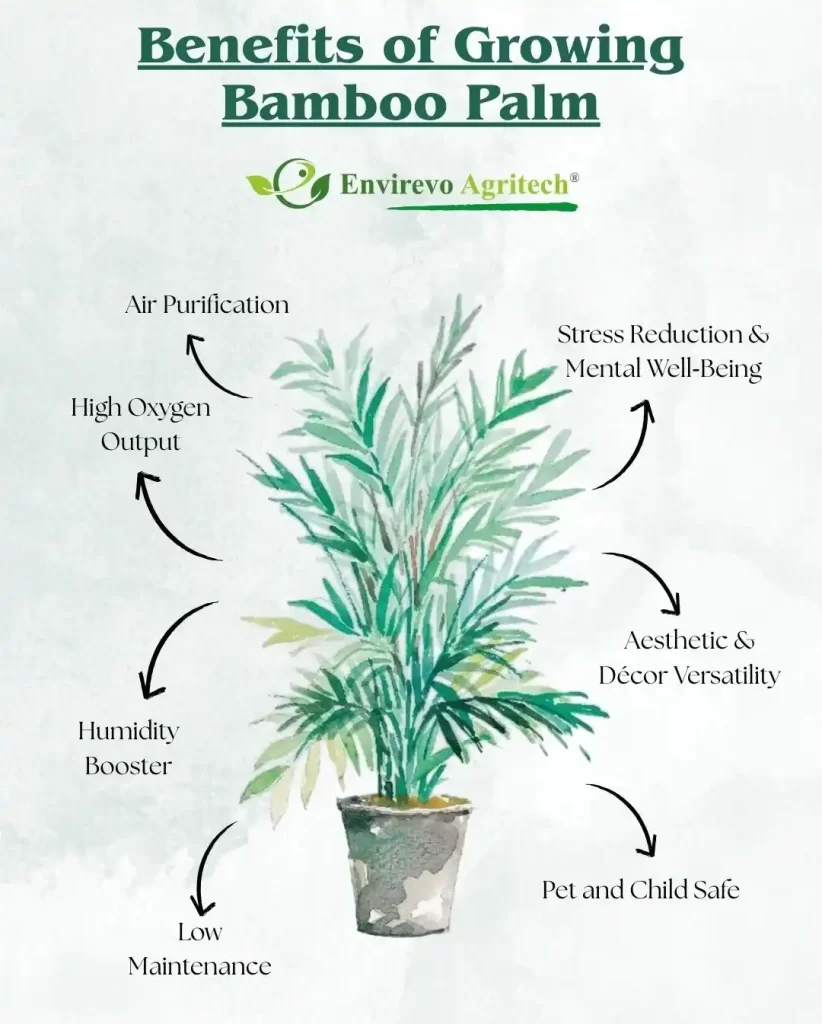
- Space Divider Functionality: Dense, clumping growth makes it perfect for natural indoor partitions or privacy screens.
- Adaptable Growth Habit: Grows well in containers, tolerates occasional neglect, and can be relocated easily to optimize light and space.
- Year‑Round Greenery: As an evergreen, it provides constant visual interest and a touch of the tropics throughout the seasons.
- Improved Focus & Productivity: The presence of houseplants like bamboo palms in workspaces is linked to better concentration and higher productivity.
- Therapeutic Horticultural Activity: Caring for indoor palms offers mindfulness and therapeutic benefits, supporting emotional well‑being.
Care for Bamboo Palm
Light Requirements
Bamboo Palms thrive in bright, indirect light but adapt to medium or even low light situations—avoid direct sun, which can scorch fronds. A north‑ or east‑facing window is often ideal; supplement with a grow light if necessary.
Temperature and Humidity
Maintain indoor temperatures between 65°F and 80°F (18–27°C). Protect from drafts, air‑con vents, and sudden temperature swings. Because these palms are native to humid rainforests, aim for relative humidity above 50%; regular misting or a pebble tray helps prevent brown tips.
Soil and Potting Mix
Use a premium, well‑draining potting mix composed of peat moss, perlite or pumice, and loamy soil. This blend retains moisture without becoming waterlogged and maintains a ph of 6.1–7.5. Ensure containers have ample drainage holes to prevent root rot.
Watering
Water when the top inch of soil feels dry—typically every 1–2 weeks, depending on season and humidity. Signs of underwatering include drooping or curled fronds, while yellowing leaves and soggy soil indicate overwatering.
Fertilizing
Feed with a balanced 10‑10‑10 or 12‑4‑12 NPK fertilizer every 4–6 weeks during active growth from spring through early autumn. Skip fertilizing in winter when growth slows to avoid salt buildup and root burn.
Potting and Repotting Your Bamboo Palm
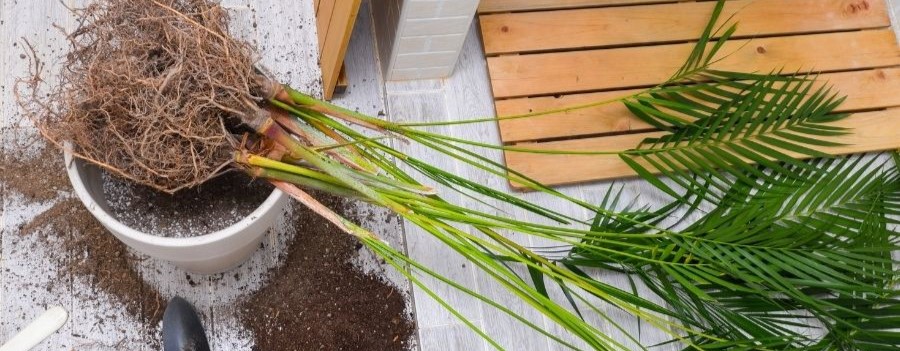
When potting your Bamboo Palm (Chamaedorea seifrizii), choose a container with ample drainage holes to prevent root rot. Use a well-draining soil mix—ideally a blend of peat moss, perlite, and loamy soil with a slightly acidic to neutral pH (6.1–7.5). Ensure the pot is only 1–2 inches wider than the root ball to avoid excess soil moisture retention.
Repotting should be done every 2–3 years or when roots become crowded and start circling the pot. Spring is the best time to repot, as the plant enters its active growth phase. During repotting:
- Gently remove the plant and shake off old soil.
- Trim away any damaged or rotting roots.
- Replant at the same depth in fresh soil.
- Water thoroughly and keep in indirect light.
Propagation of Bamboo Palm
Propagating Bamboo Palm (Chamaedorea seifrizii) is best accomplished by division, ideally during spring repotting when the plant begins active growth. Carefully remove the parent plant from its pot and gently shake off excess soil to expose the root ball. Look for natural clumps or offshoots with their own root systems, and use a clean, sharp knife or garden shears to separate these sections, ensuring each division has at least three to five healthy stems and a good portion of roots.
Once divided, plant each section in a slightly smaller container filled with fresh, well‑draining palm mix (peat moss blended with perlite or pumice). Water thoroughly to settle the soil, then maintain high humidity—either by grouping pots together, using a pebble tray, or misting regularly. Keep divisions in bright, indirect light and consistently warm (65–80 °F) until new growth confirms successful rooting.
Pruning Bamboo Palm
Pruning a Bamboo Palm is primarily about tidying up by removing dead, yellowing, or damaged fronds to keep the plant healthy and attractive. The ideal time to prune is in late winter to early spring, just as new growth begins—to avoid stressing the palm during its active growing season. Always use clean, sharp pruning shears or scissors and sterilize them before and after use to prevent the spread of disease. Cut each frond back to its base, making a single clean cut close to the main stem without damaging adjacent healthy stems. Avoid over‑pruning—only remove fronds that are fully spent—so the palm retains enough foliage to photosynthesise effectively and maintain its natural, graceful form.
Common Problems and Troubleshooting Your Bamboo Palm
Brown Leaf Tips
Dry indoor air causes tips to brown, and excess salts/minerals in tap water exacerbate leaf burn. Switching to distilled or rainwater (or letting tap water sit overnight) prevents chlorine, fluoride, and salt accumulation. Place your Bamboo palm on a pebble tray, run a humidifier nearby, or mist fronds regularly to keep relative humidity above 50 %. Using clean shears, snip away brown tips at a 45° angle to encourage healthy new growth.
Yellowing Fronds
Saturated roots can’t take up nutrients, causing fronds to yellow and wilt. Conversely, parched soil or insufficient light can also lead to chlorosis. Allow the top inch of soil to dry between waterings, and consider repotting into a mix with more perlite or pumice. Apply a diluted, balanced fertilizer every 4–6 weeks during the growing season; flush soil occasionally to remove built‑up salts.
Stunted Growth
Constantly wet soil suffocates roots, slowing or halting new shoots. Roots circling a cramped pot can’t expand, leading to diminished vigor and smaller leaves. Sudden changes—like a new spot, temperature drop, or drafts—can shock your Bamboo palm and stunt growth. In spring, divide and repot into a container 1–2 inches larger with fresh, well‑draining soil, then resume regular fertilization to reignite growth.
Common Pests & Diseases
| Pest / Disease | Common Cause | Signs to Look For |
|---|---|---|
| Spider Mites | Thrive in dry, low‑humidity conditions; introduced via infested plants, dust, or equipment. | Fine webbing on leaf undersides; tiny yellow/white stippling (“speckled” Appearance); dusty fronds; premature leaf drop. |
| Mealybugs | Favor warm, humid microclimates; hide in leaf axils; spread through contaminated tools or nearby infested plants. | https://envirevoagritech.com/how-to-treat-cercospora-leaf-spot/https://envirevoagritech.com/fusarium-wilt-prevention-control-and-damage/https://envirevoagritech.com/fusarium-wilt-prevention-control-and-damage/White, cottony clusters on stems and leaf joints; yellowing or curling fronds; sticky honeydew and subsequent sooty mold. |
| Scale Insects | Multiply rapidly in stagnant indoor air; often overlooked until infestation is severe. | Small brown/tan dome‑shaped shells on canes and fronds; sticky honeydew residue that may drip; black sooty mold growth. |
| Root Rot (Fungal) | Caused by overwatering, poor drainage, and soilborne fungal pathogens (e.g., Phytophthora spp.) | Yellowing, wilting fronds; dark, mushy roots with foul odor; slowed or stunted new growth. |
| Leaf Spot | Prolonged leaf wetness in humid environments; pathogens include fungal genera (Cyphellophora, Cladosporium) and bacteria (Pseudomonas). | Circular to angular brown/black lesions on leaflets; possible yellow halo around spots; premature leaf drop as lesions coalesce. |
| Fusarium Wilt | Soilborne Fusarium oxysporum enters via root wounds, exacerbated by excess moisture and poor sanitation. | Soilborne Fusarium oxysporum enters via root wounds; exacerbated by excess moisture and poor sanitation. |
Bamboo Palm Varieties
Several closely related species and cultivars are commonly grouped as “bamboo palms,” each with unique traits:
- Chamaedorea seifrizii (Classic Bamboo Palm): The standard bamboo‑like form, reaching up to 6 ft indoors.
- Chamaedorea elegans (Parlor Palm): A compact, slow‑growing variety with feathery fronds, ideal for small spaces.
- Chamaedorea microspadix (Hardy Bamboo Palm): A more cold‑tolerant selection, adapts well outdoors in warm regions.
- Chamaedorea cataractarum (Cat Palm): Noted for its wide‑spreading fronds and horizontal growth habit.
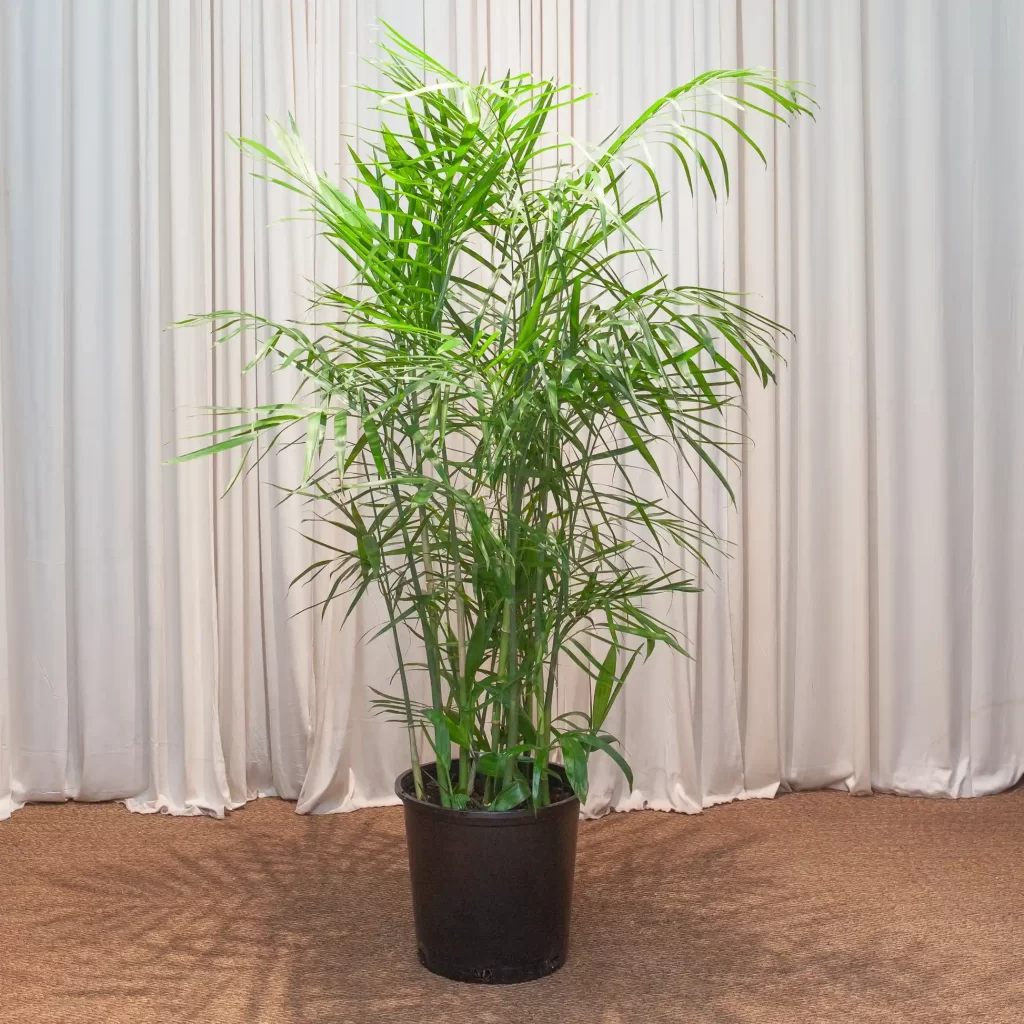
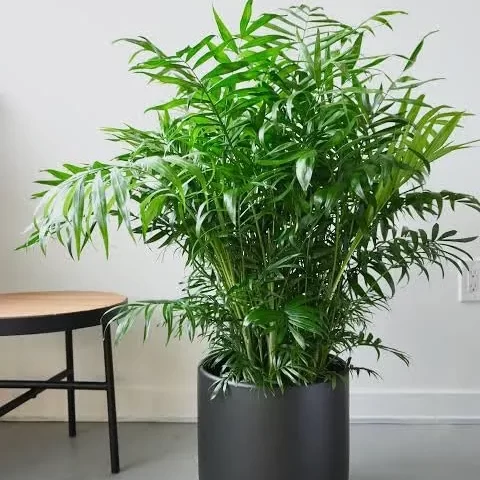
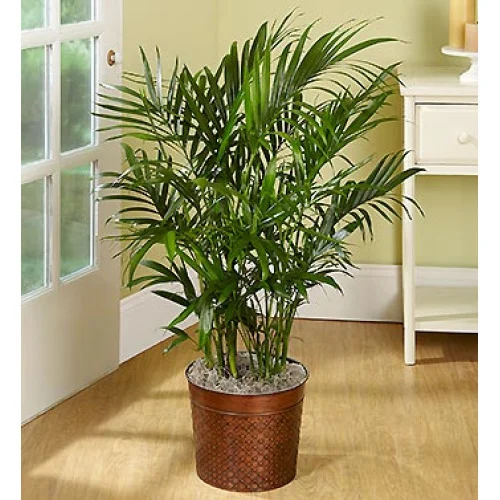
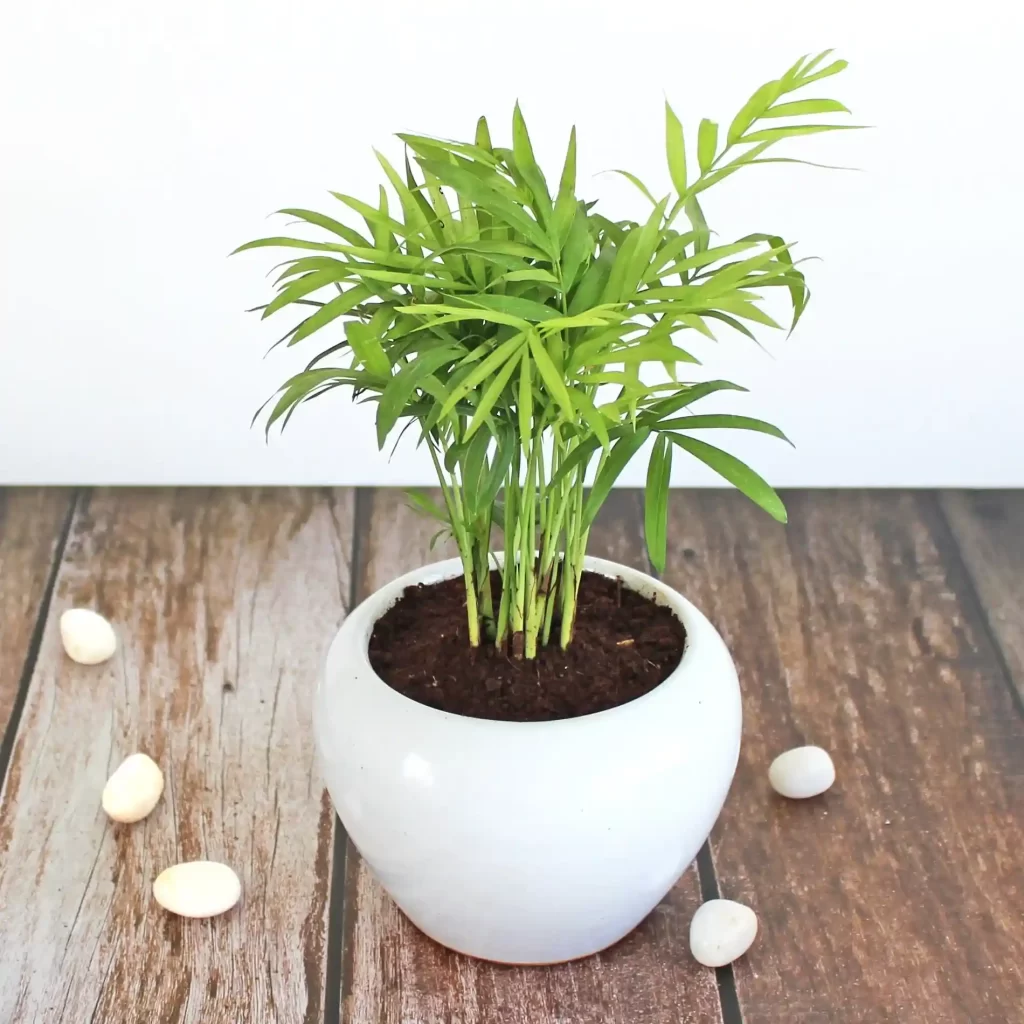
Frequently Asked Questions (FAQs)
Can Bamboo Palm Tolerate Low Light?
Yes—while it prefers bright, filtered light, it adapts well to medium and low light conditions.
How Tall Will a Bamboo Palm Grow Indoors?
Typically 4–6 ft, though some varieties like C. microspadix can reach up to 10 ft indoors.
Is Bamboo Palm Pet‑Safe?
Absolutely—Chamaedorea seifrizii is non‑toxic to cats and dogs.
How quickly does a Bamboo Palm grow?
Bamboo Palms exhibit a moderate growth rate, often extending their height by about 6–12 inches per year under ideal light and moisture conditions. Mature specimens occupy between 3–12 ft in height, typically achieving full size within 5–10 years.
Can I grow my Bamboo Palm outdoors year‑round?
Bamboo Palms tolerate outdoor cultivation only in USDA zones 10–11, where winter temperatures do not drop below 30 °F (−1 °C). In cooler regions, they must be moved indoors or provided frost protection to prevent cold damage.
Do Bamboo Palms improve indoor air quality?
Yes—as one of NASA’s recommended houseplants, Bamboo Palms filter hazardous chemicals such as formaldehyde and benzene, enhancing indoor air purity. Their dense foliage offers both aesthetic value and practical pollutant reduction over time
Final Thoughts
By providing your Bamboo Palm with bright, indirect light, consistent moisture without waterlogging, high humidity, and a nutrient‑rich, well‑draining soil mix, you’ll ensure lush fronds and steady growth all year round. Regular repotting every 2–3 years and occasional pruning of yellow or dead leaves will keep your palm looking its best and prevent it from becoming root‑bound.
Staying vigilant for pests like spider mites, mealybugs, and scale—and addressing fungal issues such as root rot and leaf spot early—will maintain strong, vibrant foliage. Combined with its proven air‑purifying capacity and mood‑enhancing presence, a well‑cared‑for Bamboo Palm becomes both a statement piece and a health‑promoting companion in your interior space. With these expert insights, you’re all set to welcome the tropical elegance of Bamboo Palm into your home—enjoy its beauty, benefits, and effortless charm for years to come.






